The effect of calcium hydroxide in combination with propolis extract on decreasing nerve growth factor and substance P expression in rat dental pulp neuron
DOI:
https://doi.org/10.4322/bds.2024.e4023Abstract
Objective: Pain sensitivity was reflected in the expression of nerve growth factor (NGF) and substance P (SP), which we used in a rat tooth perforation model to assess the efficacy of Ca(OH)2 combined with propolis extract direct pulp capping agent. The model was used to investigate the synergistic effects of Ca(OH)2 and propolis extract. Material and Methods: This experimental study used 36 Wistar rat mandibular incisors randomly divided into three groups. The rats were euthanized after 12 and 24 h. Specimens underwent histological evaluation under a light microscope to identify the presence of neuron cells; an immunohistochemistry method using anti-NGF and anti-SP1 was used to evaluate the expression of NGF and SP. The results were then statistically evaluated by one-way analysis of variance and Tukey’s honestly significant difference tests. Results: Significant differences were found in NGF expression between the Ca(OH)2 + propolis and control group (12h group p<0.001; 24h group p<0.001) and between Ca(OH)2 and the control group (12h group p=0.001; 24h group p<0.001). Significance differences in SP expression were also found between the Ca(OH)2 + propolis and Ca(OH)2 groups and between the Ca(OH)2 + propolis and control groups (12h group p<0.001; 24h group p<0.001). Conclusion: Ca(OH)2 combined with propolis extract as a direct pulp capping agent can inhibit dental pain response because the main active ingredients of propolis are caffeic acid phenethyl ester and flavonoids which can inhibit the release of prostaglandin, thereby inhibiting SP secretion, but not NGF expression.
KEYWORDS
Calcium hydroxide; Dental pulp capping; Nerve growth factor; Propolis; Substance P.
Downloads
Published
How to Cite
Issue
Section
License
Brazilian Dental Science uses the Creative Commons (CC-BY 4.0) license, thus preserving the integrity of articles in an open access environment. The journal allows the author to retain publishing rights without restrictions.
=================




























